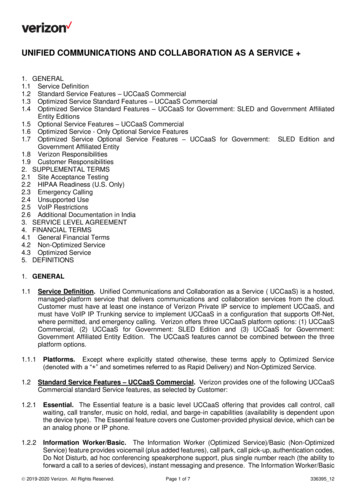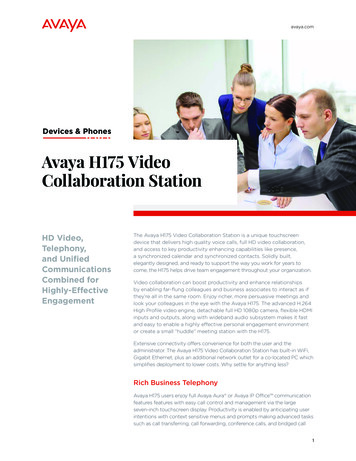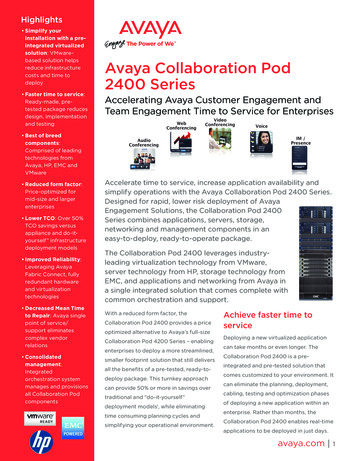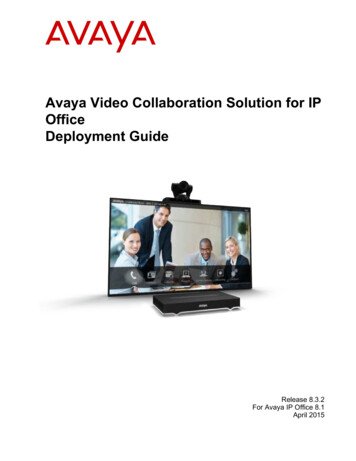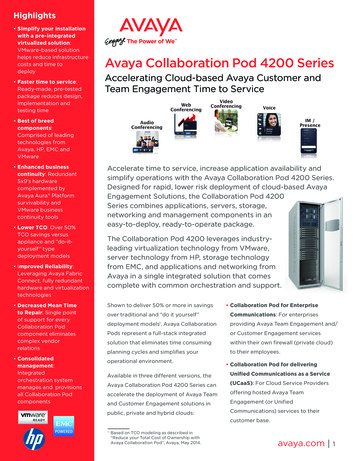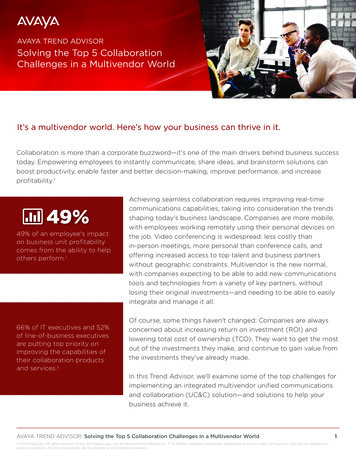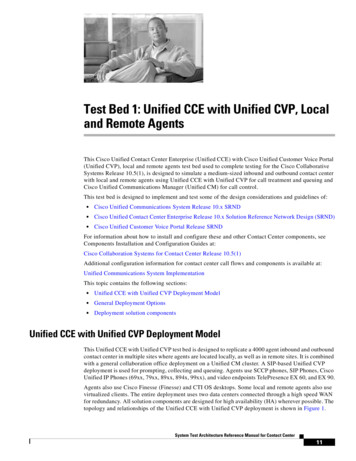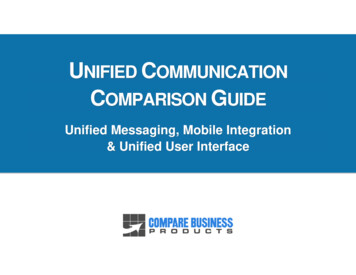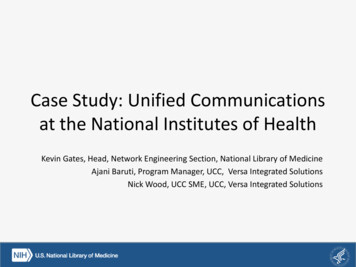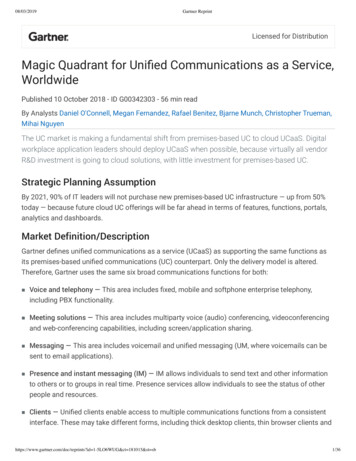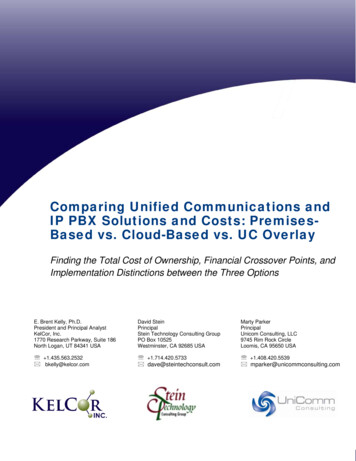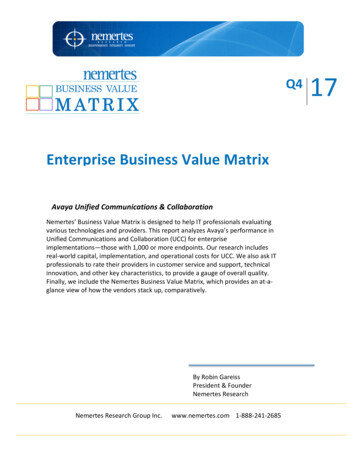
Transcription
Q4Enterprise Business Value MatrixAvaya Unified Communications & CollaborationNemertes’ Business Value Matrix is designed to help IT professionals evaluatingvarious technologies and providers. This report analyzes Avaya’s performance inUnified Communications and Collaboration (UCC) for enterpriseimplementations—those with 1,000 or more endpoints. Our research includesreal-world capital, implementation, and operational costs for UCC. We also ask ITprofessionals to rate their providers in customer service and support, technicalinnovation, and other key characteristics, to provide a gauge of overall quality.Finally, we include the Nemertes Business Value Matrix, which provides an at-aglance view of how the vendors stack up, comparatively.By Robin GareissPresident & FounderNemertes ResearchNemertes Research Group Inc.www.nemertes.com 1-888-241-268517
TABLE OF CONTENTSAbout The Business Value Matrix Research . 3Enterprise UCC Value Matrix Findings . 3Providers Included . 3Avaya’s Performance . 4Enterprise Customer Ratings . 4Enterprise Costs . 5Industry Findings . 7Management Tools . 7Architecture Trends . 8Conclusion . 9Research Methodology .10Demographics .10By Number of Employees . 10By Industry. 11TABLE OF FIGURESFIGURE 1: ENTERPRISE UCC VALUE MATRIX . 3FIGURE 2: USER SENTIMENT TABLE, ENTERPRISE UCC . 5FIGURE 3: UC TCO FIGURES, AVAYA VS. AVERAGE . 6FIGURE 4: WHY MOVE TO THE CLOUD? . 8FIGURE 5: SIZE, BY NUMBER OF EMPLOYEES . 10FIGURE 6: RESEARCH PARTICIPANTS, BY INDUSTRY . 11
About The Business Value Matrix ResearchNemertes conducted research on Unified Communications and Collaboration plans andcosts during the first quarter of 2017. We interviewed or surveyed 723 companies fromvarious industries, and ranging in size from 50 employees to hundreds of thousands ofemployees. (Please see the addendum for more details.) Nemertes has conducted thisresearch independently for 12 years; no one sponsors it.In addition to asking IT professionals detailed questions about their costs, we also askedthem to rate their providers in six core areas. We then plotted their average first-year costson the Y-axis of a matrix, and their average rating on the X-axis. In this report, we exploreAvaya’s performance in the Enterprise UCC Value matrix. (Please see Figure Low%%%Customer%Ra2ngs%%%High%Figure 1: Enterprise UCC Value MatrixEnterprise UCC Value Matrix FindingsProviders IncludedIT providers cited a few dozen vendors who provide UCC capabilities; seven of themreceived enough ratings to be counted individually. Those included are a mix of platform3 Nemertes Research 2017 ! www.nemertes.com ! 888-241-2685 ! DN6454
providers (Alcatel Lucent, now ALE, Avaya, Cisco, IBM, and Microsoft) and communicationsservice providers (AT&T and Verizon).Not all providers offer the same UCC capabilities. The point of the research, however, wasto measure whom enterprise IT leaders consider their UCC providers and how they ratethem—regardless of what combination of services they use. All provide collaboration capabilities, such as instant messaging, presence,web/audio/video conferencing.The CSPs offer hosted services, and AT&T provides its own Broadsoft-based UCaaS.IBM and Microsoft also provide email/calendar platforms. All but IBM provide voicecapabilities.Alcatel-Lucent, Avaya and Cisco are the only providers with their own contactcenter platforms.Although we did not ask companies to rate their contact-center providers in this research,their ability to offer contact-center capabilities is relevant to their UCC decisions. Manyorganizations want to integrate their corporate UCC system or service with their contactcenters. The driver is making any employee a potential customer-service agent. With theappropriate UCC integration, true contact-center agents can find presence status on anyemployee, and join them in a call, screen share, video conference, or other type ofcollaborative call. IT leaders say they can reduce the staffing requirements by leveragingtechnology from a single provider, vs. using multiple providers. Indeed, 37% already usethe same provider, a practice that correlates with contact-center success in our research.Avaya’s PerformanceAvaya’s customers are pleased with the technology, response time, reliability andinteraction across the board. They also have low Total Cost of Operations (TCO). Amongenterprise organizations, Avaya performs best when evaluating both cost and customerratings among UCC providers that offer voice and collaboration capabilities—regardless ofarchitecture. This analysis includes cloud, on-premises, and hybrid deployments.Enterprise Customer RatingsAvaya’s top-rated area among enterprises is reliability; that rating is also highest among allother providers rated by enterprises. Avaya also scores above average in technologyfeatures, response time, and account team interaction. (Please see Figure 2.)4 Nemertes Research 2017 ! www.nemertes.com ! 888-241-2685 ! DN6454
vation Transformation .05Figure 2: User Sentiment Table, Enterprise UCCReliability is an underpinning of any product or service in the IT space. After all, what valueare solid technology features, fast response time, or innovation if their products andservices are not reliable? During interviews, IT leaders said Avaya’s UCC and contact-centerplatforms are solid in terms of reliability—key to decreasing operational costs by reducingthe staff hours required to troubleshoot outages.Enterprise CostsAvaya has performed well historically in Nemertes’ UCC Total Cost of Operations research,and 2017 is no exception. Nemertes measures capital, implementation, and operationalcosts, and Avaya’s costs are lower than average in each of those areas. We also total thefirst-year costs (sum of capital, implementation, and one year of operational costs perendpoint); at 473 per endpoint, Avaya’s overall first-year costs also are lower thanaverage, by 16%. (Please see Figure 3.)5 Nemertes Research 2017 ! www.nemertes.com ! 888-241-2685 ! DN6454
Avaya UCC Costs1,000 EndpointsAvayaAverage 600 565 500 473 400 300 200 213 225 100 88 - 135Implementation 205 173CapitalOperationalFirst Year TotalFigure 3: UC TCO Figures, Avaya vs. AverageNemertes gathers several data points to calculate the costs in each metric. Here is how wecalculate the numbers: 6Capital cost per endpoint: Includes PBX, endpoint devices and licenses, servers,other hardware. In some cases, bundled licenses include certain UC appso Capital costs / number of endpoints (handsets, softphones, etc.)Implementation cost per endpoint: Includes staff time and third-partyconsultants and integratorso ((Staff time * loaded hourly rate) third-party costs)/ number ofendpointsOperational cost per endpoint: Includes staff time measured as Full TimeEquivalents (FTEs), equipment maintenance, third-party managed services,training and certification (see descriptions below)o ((Number of FTEs * average annual loaded salary) equipmentmaintenance managed services training/certification) / number ofendpoints Nemertes Research 2017 ! www.nemertes.com ! 888-241-2685 ! DN6454
Extending the figures out for a traditional three-year TCO, Avaya’s enterprise UCC rollouts(typically with Aura) cost its customers 818 per endpoint, which is the second lowest of allenterprise providers measured.Operational costs are the most important because, unlike the one-time capital andimplementation costs, they continue year over year. Avaya’s operational costs are 15.6%less than average, which is a key reason its three-year TCO is impressive. UCC operationalcosts include the following: Internal Staff Time – Includes the fully loaded (overhead for benefits and taxes)salaries of full-time equivalent employees managing UCC.Third-Party Managed Services – Includes total costs for third-party managedservices. This does not include initial consulting or systems integration associatedwith the implementation.IT Staff Training and Certification – Includes instructor fees, travel, coursematerials, and certification fees.User Training – Includes third-party training costs and/or the fully loaded salariesfor internal staff that train employees on UCC.Equipment Maintenance – Includes annual costs for equipment maintenance. Thiscan apply to on-premises or cloud deployments, as cloud deployments typically stillinclude maintenance on handsets and servers.Cloud Subscription – Includes monthly subscription costs for cloud UCC serviceswhere relevant.Industry FindingsIn evaluating findings by industry, we did not have enough data to analyze each provider ineach industry. In Avaya’s case, we had enough cost data for financial services, healthcare,education, and manufacturing.Avaya’s first-year costs were lower than average in manufacturing, and at average forhealthcare. Its operational costs are lower than average in education and manufacturing.Management ToolsAnother notable result from the research is that Avaya’s UCC management tools land inthe top right section of the Enterprise and Midmarket UCC Management Value Matrix,meaning IT leaders rate the management tools among the best. Other provider tools ratedinclude administration/operations management (Riverbed, Voss, and Unimax),performance management (IR, Nectar, Riverbed), and UCC platform (Avaya, Cisco).7 Nemertes Research 2017 ! www.nemertes.com ! 888-241-2685 ! DN6454
Additionally, Avaya’s management tools reduce overall UCC operational costs, primarily byproviding insight that reduces IT staffing requirements. The cost component of the UCCManagement Value Matrix does not represent the cost of the tool itself. Rather, it is theassociated operational cost for the UCC solution under management. Management toolsare a relatively small part of overall UCC costs. What’s more relevant to organizations is theextent to which management tools can reduce overall operational costs.Architecture TrendsMost organizations are evaluating or planning to move at least some UCC apps to thecloud. However, a growing percentage (15%, up from 9% in 2016) has decided againstcloud and plans to stay on premises. (Please see Figure 4.) Large enterprises are not aslikely as small and midsize businesses to move all of UCC to the cloud. Many are getting ataste of cloud through the use of use Platform as a Service and Infrastructure as a Servicefor a variety of functions. With UCC, though, many large enterprises remain hesitant to puteverything in the cloud immediately, opting to move slowly with apps like email and webconferencing first.Why have you moved/are considering a move to the cloud?33%Perceived cost reduction29%Improved agility for IT21%Security concerns now addressed18%More features available in cloud services18%Can roll out services faster from the cloud16%Must free IT staff for strategic initiatives15%Not considering cloud at all12%Executive mandate12%Providers investing more in cloud than on-prem10%Can't get budget for IT staff, but can for services6%Acquired right tools/services to help with cloud migrationOther4%Down from 49% in 2016.Cost savings not drivingcompanies to the cloud, aswe find costs actuallyincrease!Up from 9% in 2016. ITleaders more cautiousabout moving to the cloud.Figure 4: Why Move to
endpoint); at 473 per endpoint, Avaya’s overall first-year costs also are lower than average, by 16%. (Please see Figure 3.) Provider Technology/ Features Response/ Time Reliability InteractionInnovation Digital/ TransformationAVERAGE IBM 3.57 3.43 3.43 3.57 3.29 3.43 3.45 Avaya 3.41 3.06 3.44 3.06 3.00 2.81 3.12 Cisco 3.25 2.98 3.25 3.00 3.06 2.90 3.08

